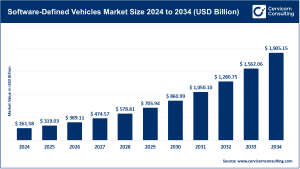Plug-In Hybrid Electric Vehicles Market Overview
The global plug-in hybrid electric vehicles market stands at the forefront of the global shift toward sustainable mobility solutions. The market was valued at USD 52.27 billion in 2024 and is anticipated to reach USD 265.62 billion by 2034, reflecting an impressive CAGR of 17.65% during 2025–2034. This robust expansion stems from rapid technological innovation, evolving policy frameworks, and consumers’ growing preference for cleaner, flexible transportation options. Positioned between fully electric and traditional combustion-engine vehicles, PHEVs combine electric-only driving capabilities with the reliability of gasoline engines, providing the ideal transitional technology as global charging infrastructure continues to expand.
📄 Get a Free Sample: https://www.cervicornconsulting.com/sample/2791
Key Market Trends
1. Battery and Powertrain Technology Advancements
Continuous innovations in lithium-ion and solid-state battery systems are revolutionizing PHEV performance. Automakers such as BMW, Toyota, and BYD have adopted higher-capacity batteries that extend electric-only ranges beyond 80 km, boosting both efficiency and consumer confidence. Enhanced powertrain integration and cost reductions are further accelerating mainstream adoption across various vehicle types.
2. Strong Regulatory and Incentive Support
Policy-driven growth remains a key enabler of the market’s trajectory. Government initiatives like the U.S. Inflation Reduction Act, the EU’s Fit-for-55 framework, and China’s New Energy Vehicle (NEV) subsidies provide tax credits and stricter emission caps, prompting OEMs to broaden their hybrid portfolios. These frameworks reinforce investment in cleaner technologies to meet global carbon neutrality goals.
3. Dual Electrification Strategies Among Automakers
Global OEMs are pursuing parallel strategies—expanding both fully electric and PHEV lineups. Companies like Volkswagen, Ford, and Mercedes-Benz are launching plug-in hybrid variants across sedans, SUVs, and commercial vehicles to balance regional infrastructure readiness with emission reduction mandates.
4. Emergence of Smart, Connected Hybrids
Artificial intelligence and connectivity are transforming the PHEV driving experience. Features such as predictive energy management, over-the-air (OTA) updates, and real-time performance optimization—pioneered by leaders like BMW and Tesla—allow vehicles to automatically adjust energy use based on driving conditions, enhancing efficiency and user convenience.
5. Widespread Consumer and Fleet Adoption
As PHEVs achieve greater range and lower lifetime costs, they are being embraced by both retail consumers and corporate fleets. Ride-sharing and delivery operators across Europe and North America increasingly prefer PHEVs for their ability to reduce emissions without sacrificing range or operational flexibility.
Market Drivers
Technological Innovation and Cost Efficiency
Advancements in modular hybrid architectures and power electronics have trimmed production costs by 10–15% in recent years. Battery costs are projected to drop below USD 100 per kWh by 2030, making plug-in hybrids more affordable to mainstream buyers.
Stringent Emission Regulations
With emission norms tightening globally—such as Euro 7 in Europe and China VI standards—automakers are integrating hybrid technologies to comply with emission caps while preserving performance standards. PHEVs serve as a crucial compliance bridge in the gradual journey toward full electrification.
Range Flexibility Driving Consumer Preference
PHEVs eliminate the “range anxiety” often associated with EVs, providing both electric and combustion-based operation. This flexibility appeals particularly to consumers in regions where charging networks are still in development, such as parts of Asia, Africa, and Latin America.
Expansion of Charging Infrastructure
According to the International Energy Agency (IEA), global public charging stations surpassed 4 million units in 2024, marking a 50% increase over 2022. This rapid expansion directly supports PHEV adoption by enhancing convenience and accessibility.
Fleet Electrification Programs
Corporate and government fleets are rapidly integrating PHEVs to meet sustainability mandates and reduce fuel expenses. Public tenders across Europe and Asia increasingly require hybrid fleets for municipal transport and logistics operations, bolstering institutional demand.
Impact of Trends and Drivers
The convergence of these factors is transforming the PHEV landscape across segments and regions:
-
Passenger Vehicles: Premium and mid-range PHEVs continue to dominate, blending luxury features with enhanced efficiency.
-
Commercial Fleets: Plug-in hybrid vans and delivery vehicles are emerging as preferred solutions for last-mile logistics, balancing cost and sustainability.
-
Regional Dynamics:
-
China leads both production and consumption, driven by strong domestic manufacturing and policy incentives.
-
Europe maintains regulatory leadership, with Germany, France, and the UK offering comprehensive subsidies.
-
North America is experiencing rapid growth, supported by federal and state-level tax credits and new hybrid models from Ford, GM, and Toyota.
-
Collectively, these developments are reshaping competition, spurring innovation, and accelerating the transition toward hybrid-electric mobility worldwide.
Challenges and Opportunities
Challenges
-
Policy Volatility: Fluctuating government subsidies in key markets like China and Europe could impact long-term growth stability.
-
Infrastructure Gaps: Limited availability of high-capacity charging points in rural and developing regions continues to constrain adoption.
-
Consumer Misconceptions: Persistent doubts about maintenance costs and long-term performance hinder first-time buyers.
Opportunities
-
Emerging Market Growth: Developing nations in Southeast Asia, Africa, and Latin America represent untapped potential, supported by early-stage EV incentives.
-
Technological Convergence: The integration of renewable-powered charging, vehicle-to-grid (V2G) systems, and AI-driven optimization opens new revenue and service opportunities.
-
Strategic Partnerships: Collaborations such as BYD–Toyota and Ford–SK On exemplify the growing synergy between automakers and battery specialists, boosting innovation and scalability.
Future Outlook
The plug-in hybrid electric vehicles market is set for a transformative decade, projected to reach USD 265.62 billion by 2034, growing at a CAGR of 17.65%. PHEVs will remain a critical bridge technology within the global electrification roadmap—offering the practicality of dual powertrains alongside the sustainability of electric mobility.
The next generation of PHEVs will feature solid-state batteries, integrated digital systems, and intelligent energy management capabilities, seamlessly merging performance with environmental responsibility. For markets where affordability and infrastructure still pose challenges, PHEVs will continue to deliver the balance consumers and fleets seek—making them a foundational element of the automotive industry’s clean-energy evolution.
For a detailed market analysis and forecast, visit: Cervicorn Consulting
